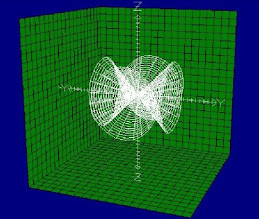
I'm discovering the Wallis product thanks to an approach involving geometry of areas. In order to relate that to what has already been written on the subject, here are some works which I would like to study in the coming time:
- the appropriate parts of John Wallis' Arithmetica Infinitorum (is there a translation online ?)
- Some generalizations of the Wallis product (1992), by Les Short, containing a general formula for different starting ratios
- An Elementary Proof of the Wallis Product Formula for pi (2005), by Johan Wästlund
Maybe you have other suggestions on this subject.
Meanwhile, I tried to draw equilateral triangles in the exhaustion scheme of nested circles. We start from the concentric rings of same area as described in Figure 4 of the Variations of circular area division into equal parts post. Remember the inner circle has radius 1 and area π. Each subsequent Nth circle has radius square root of N (noted √N) and area Nπ. Then we can draw an equilateral triangle whose sides are tangent to the first circle. The neat thing about this procedure is that we can read out the pertaining numerical values right on the figure. Figure 1 shows us that the area of the equilateral triangle is 3√3. So the ratio between the outscribed equilateral triangle area and the circle area is equal to 3√3/π.
By drawing equilateral triangles tangent to circles of incrementing area Nπ, we discover the nested equal area division for equilateral triangles: the area between each equilateral triangle is equal to 3√3 (see Figure 2, you can click on the figure to view it enlarged). Among other interesting features, this figure contains the table of 4. For each triangle outscribing a circle of radius √N, its vertices are located on the circle of order 4×N.
If we outscribe alternately a circle, a triangle, a circle, a triangle, a circle, etc., the circles (and the vertices of the triangles) go through the subsequent powers of 4, see Figure 3. By changing the form of the triangle, we have access to other tables and powers. It seems there are plenty of properties that are hidden in this structure.
Now, we can try the Wallis exhaustion scheme on the nested circle and triangle structure. The procedure apparently goes something like:
Step 1. Draw the initial circle and triangle with area ratio 3√3/4π.
Step 2. A better fit would be to inscribe both figures in higher orders of the nested structure. But the area of the triangle is too small with respect to the circle. So we must enlarge the area of the triangle more than the circle. We enlarge the area of the triangle by 3 while leaving unchanged the area of the circle. This is illustrated in the figure below.
Step 3. But now the area of the triangle is too large with respect to the circular area. So for this fit, we must enlarge the area of the triangle a little less than the area of the circle. We therefore enlarge the area of the triangle by 3, while enlarging the area of the circle by 4, as illustrated below.
Step 4. But now the area of the triangle is too small with respect to the circular area. So for the next fit, we must enlarge the area of the triangle a little more than the area of the circle. We therefore enlarge the area of the circle by 6, while enlarging the area of the circle by 5, as illustrated below.
This exhaustion scheme that makes the area of equilateral triangles alternately larger, smaller, larger, smaller, etc... than the circular area can be written as:
This formula corresponds to an infinite product approximating π, which I've found in a French book Le fascinant nombre π by Jean-Paul Delahaye but I couldn't find it mentioned elsewhere. As approximation method, it is about twice as fast as Wallis' original product. This equilateral triangle exhaustion product is probably a special case in a large family of Wallis products, each of which pertaining to a particular geometrical configuration from which one tries to approximate π. The starting and recurrence conditions depend on the form and the initial area ratio between the polygon and the circle. The rules governing this exhaustion scheme in the general case still elude me.










No comments:
Post a Comment